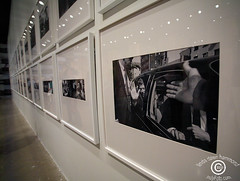2 Yet Unknowns reaching out... Bill Clinton, meet Ai Weiwei, 1989
Exhibition of photography taken by Ai Weiwei during the years 1981 to 1993, when he lived in the United States. He studied briefly at Parsons School of Design and at the Art Students League of New York, eventually choosing Alphabet City, a volatile and fascinating Lower East Side neighborhood of NYC. There he documented the art and literary scene which, as the son of a well known Chinese dissident, the poet Ai Qing, he soon gained entree. One neighbour in particular, the Beat poet Allen Ginsberg, had previously met his father in Beijing. This friendship led Ai Weiwei to encounter others of significant stature in the arts community, such as renowned photographer/filmmaker Robert Frank, also included in this selection of photos. He also documented intimately his friends in the expat Chinese art community, but those images do not predominate here. It comes as no surprise that he expressed interest in the artistic practice of Andy Warhol's factory, as reflected in the MOMA self-portrait, as Ai's embrace of the "cult of personality" to advance one's message and career is a distinctly American one.
As someone I presume was on a visitor's visa, what's more impressive is that he engaged in closely documenting political events which took place in NYC in the late 1980s. The courage he exhibits here is suggestive of what will follow once he returns to China. The Tompkins Square riots, during which squatters, artists, punks and anarchists tackled issues of homelessness and poverty with Direct Action techniques, were violently subdued by local police and it is at these events where Ai obtained his most successful photographs.
The exhibit ends on a smiling Clinton waving at the camera as he departs in a car in 1989, both subject and photographer relatively unknown at the time but as history will reveal, destined for greatness and notoriety. It is important to remember that this is just a small selection of the thousands of admitted "snapshots" Ai Weiwei took in NY, which were reduced to 227 for a previous project, Ai Weiwei: New York Photographs 1983 – 1993, Exhibit and Book.
For an excellent analysis of his photography by writer Gail Pellett-
gailpellettproductions.com/ai-weiwei-new-york-1983-1993/
Linda Dawn Hammond
AGOAiWeiWei_20130907_053







